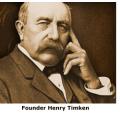- Bearings
- Belts
- Bike Bearings
- Grease
- Kukko
- Linear Bearings
- Loctite
- Oil Seals O Rings Circlips
FREE UK MAINLAND DELIVERY ON ORDERS OVER £100Bearing King Articles TIMKEN Tapered Roller BearingsTIMKEN Tapered Roller Bearings
 The inside story of TIMKEN
The inside story of TIMKEN
The first tapered roller bearing was patented in 1802 by a French inventor, M. Cardinet. Little progress was made during the next 80 years.
But near the close of the nineteenth century, Henry Timken, a successful carriage builder in St. Louis for many years, made his first drawing of the tapered roller bearing. It resulted from his search for the bearing that would best withstand the rugged service in carriage and wagon wheels.
1898 Henry Timken and R. Heinzelman took out a patent on June 28, 1898 for a tapered roller bearing mounted in the wheel hub of horse-drawn vehicles. This early design of the Timken bearing consited of a full set of rollers but no cage or retainer. Rollers were held in alignment by two grooves cut into the rollers which engaged mating ridges on the cone. Contact of the wall of the groove in the roller with the edge of the cone was in a straight line. Henry Timken's two sons, Henry and William, formed The Timken Roller Bearing Axle Company in 1899, and, in 1901, moved the business to Canton, Ohio. Research and development of the Timken tapered roller bearing have never ended.
1901 The next big improvement came with the addition of retainers to hold the rollers in assembly with the cone. This Timken bearing featured a built-up cage with end rings tied together with pins. The function of the cage was to prevent rollers from rubbing against one another and to hold the rollers in alinment. With the automobile industry's adoption of this bearing, outer cups or raceways were first introduced with it. Success of the new bearing was immediate. And with growth of the automobile industry, demand for the new tapered roller bearing grew.
1907 An important advance was the use of a one piece, pressed steel cage which eliminated the pintles on the ends of the rollers. The cage both guided and spaced the rollers about the cone, kept rollers aligned. It helped reduce friction, permitted higher bearing speeds, increased bearing life.
1910 This more compact bearing marked a new step forward. Because the bearing could be mounted in smaller space, engineers could include it in more positions in automobiles, trucks and tractors. Wings on the cage guided the rollers and kept them properly aligned. The flange at the smaller end of the rollers as well as the wings extending along the rollers was turned in. Outer edge of the cage was crimped to get close running tolerances between rollers and cage.
1917-1918 Here was a major development in simplifying the design of the Timken bearing through elimination of flanges on each end of the cage and along the length of the rollers. Cage pockets were punched out to provide a close fit along the rollers and keep them properly spaced and aligned on the cone. Bearing width was reduced even more without sacrificing load-carrying capacity, by removing the nib from the small end of the roller. This improvement contributed tremedously toward better industrial design, lower cost and less weight.
Today's modern bearing Through all the years of its development the basic principle of full line contact between the rollers and races has never varied. However, alignment of rollers and races in in today's bearing is maintained by wide area contact of the rollers with the cone rib. The only function of the cage is to space the rollers. No other tapered roller bearing can match the Timken bearing for quality and precision and continued research at Timken assures bearing users that the No. 1 bearing for value will always be the Timken tapered roller bearing.
+44 (0)1709 527 269Monday to Friday (08.30 - 17.00)
• Privacy Policy • Terms and Conditions of Use © Bearing King 2020, Unit 5, Northfield Business Park, Forge Way, Parkgate, Rotherham, S60 1SD C2 • 2024-07-27 10:39:07 - Belts





